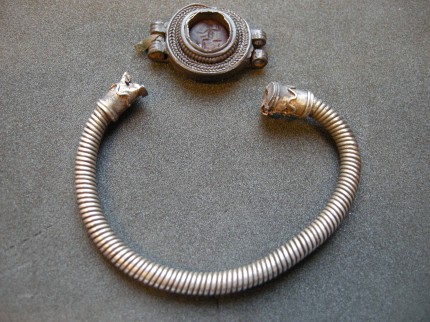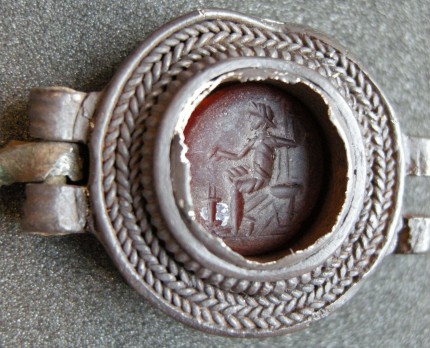
On July 26th, 2012, a metal detectorist found a Roman bracelet near Dalton, Cumbria, northwestern England. It was broken in two pieces: a twisted tube made out of spiralled silver wire and a hinged round bezel with a red gemstone intaglio of Jupiter. Dating to the 2nd or 3rd century A.D., this bracelet is a very rare artifact, especially so for the Furness area because no Roman structures have ever been found there. Plenty of Roman coins have been, but not high-end jewelry like this piece. The artifact thus testifies to the wide range of Roman trade reaching the ends of the empire, or it may point to a settlement that hasn’t been unearthed yet.
The finder reported it to the Portable Antiquities Scheme liaison and the subsequent coroner’s inquest declare it official treasure trove. Since then, the bracelet has been at the British Museum where experts were studying it and assessing its market value so a local museum, in this case the Dock Museum in Furness, could acquire it. The price was modest compared to some of the major treasure finds — just £1,800 ($3,000) — but small local museums don’t have acquisition budgets so they had to raise the funds.
Thanks to a donation from the Furness Maritime Trust, the Dock Museum is now the proud owner of this beautiful and rare piece of jewelry. It will go on display on March 14th in the museum’s new archaeology gallery. There will be associated workshops at the end of the month that schools have been invited to, and on Saturday, April 12th, a free Roman-themed family fun day.
It’s only fair that such a handsome piece of jewelry would inspire all kinds of new exhibitions and events at the museum. I think the striking spiral wire design with filigree terminals is reminiscent of a torc while the intaglio is a Greco-Roman classic. That’s not to say this was a hybrid of British and Roman workmanship. The thick spiral-twisted wire band with elaborate terminals and an engraved gemstone set in hinged bezel center is a design that has been found far, far away from Britannia. A similar silver hinged bracelet was found in Slovenia. Gold examples have been found in Syria and Egypt. This was an import, and an expensive one at that.
From the curator’s report for the treasure inquest:
The distorted elliptical hoop comprises a fine and evenly-twisted, tightly-spiralled tube made from circular-sectioned silver wire. Quite heavy wear is visible on both sides of the hoop. What appears to be the central core, around which the wire was spiralled, is visible under magnification in those places where distortion has slightly ‘opened’ the twisted strands, but its composition is uncertain. Each terminal is enclosed in a tubular collar which is decorated with an applied central meander filigree wire flanked by a double-ring edge-moulding. […]
The large circular bezel, a hollow box construction of silver sheet, has a plain back and sides. Its ornate upper face comprises an outer basal zone of herringbone pattern, formed from three concentric circles of twisted wire, and a central raised open dome with ribbed side and stepped, apparently rubbed-over, setting. The oval gem, seemingly of translucent orange-red colour, has dropped out of position to the base of the box-setting, presumably as a result of the deterioration and loss of an original organic packing. Engraved into its lightly convex surface is the image of a seated Jupiter, with wreath and full-length drapery, holding a sceptre in his left hand. In his extended right hand he holds a patera above a stylised flaming altar.
Whoever owned this bracelet had to be very wealthy. Dock Museum curator Sabine Skae speculates that it belonged to a wealthy Furness woman, native rather than Roman, who could afford the best and wanted to show it off.

Hello, can you offer me any insights you might have on how the British Museum came up with such a low dollar amount for what appears to hold more value, even if it is just based on the fact it is so rare.
Also, how does the process unfold for the metal detectorist who find such a treasure? The submit it to their government, but what happens next, and in a case like this where the amount seems low, go they have the option of petitioning for a reexamination, or are they usually content with the results.
This process has always been a mystery to me. If you could help shed light on it, I would appreciate it greatly.
Best wishes,
-Tom
The valuation process is not entirely transparent so I can’t say exactly why the BM experts came up with the figure they came up with. However, Roman jewelry does turn up at auction not infrequently, so there are solid comparisons to go on. You’d be amazed how relatively inexpensive ancient jewelry can be. Because it’s so precious to us nerds, we tend to think it’s all extremely valuable on the market too, but that’s not necessarily so. For example, here’s a whole hoard of jewels that sold for less than $3,000.
Okay, so the way it works in the UK is, the finder takes what he’s discovered to the local Finds Liaison Officer of the Portable Antiquities Scheme. These are usually experts from a local museum or antiquarians. The expert determines as much as possible age and materials, then, assuming the find is older than 300 years, it is sent to the British Museum where a panel of experts prepare a report and do any immediate conservation work necessary. That report is delivered to the local coroner where the discovery was made. The coroner holds a treasure inquest to determine if it meets the criteria (precious metals, age).
If the artifact is declared treasure, then it belongs to the Crown. The finder and landowner get to split what is basically a finder’s fee in the amount of the market value of the piece as assessed by the BM report. The local museum gets first stab at it. If they want the item, they must pay the market value to the finder. If they don’t want it, other museums in the country have a chance to buy it. If no institutions want it, the finder can sell it himself.
There is no valuation appeal process, as far as I know. The BM report stands no matter how dissatisfied the finder may be. The aim of the program is to give people incentive to turn in their finds, not to make their dreams of hitting the jackpot come true.
I could see that easily being sold today!
I’d easily buy it.
Lacking any expertise, I would possibly buy into the ‘hybrid of British and Roman workmanship’ hypothesis. The bracelet itself seems to be gold-plated, the socket appears to be unplated and the gem almost looks like a -possibly older- signet ring. A closer analysis of how the socket might have been connected to the bracelet might reveal a bit more. My wild guess might be nonsense, though.
I don’t think there’s any evidence for the hybrid hypothesis. The range of this style of bracelet suggests they were manufactured somewhere more central in the Roman empire and then exported.
Thank you, that was very helpful. Both my Mother and Father were Scottish, and it was my great grandparents that came to the US. I wrote to the Scottish Government, and asked them if I could come back, and they politely said no thanks.
It is so rich in History. We live in the Rocky Mountains of Colorado, and are able to fine nails, buckles, hinges, tools, old bottles and the like, but nothing is older than 150 years and has more value to the bugs living under it than it does to any human. I can only imagine what it would be like to live in a land so packed with history and you can see it wherever you go; you are surrounded by it.
Thank you again for taking the time.
-Tom
I have recently acquired a silver bracelet of almost this exact likeness. The only difference is there is no gem or broken hinged box charm. There are two heads which seem to represent a ram or a dragon of som sort. I know there are many ancient torc bracelet with this description, however this bracelet is the only one I can find that mimics the exact tight spiral technique used. And the description is spot on with my bracelet as well.
“The distorted elliptical hoop comprises a fine and evenly-twisted, tightly-spiralled tube made from circular-sectioned silver wire. Quite heavy wear is visible on both sides of the hoop. What appears to be the central core, around which the wire was spiralled, is visible under magnification in those places where distortion has slightly ‘opened’ the twisted strands, but its composition is uncertain.”
The weight is 156 grams. And it tests positive for Sterling. Looks extremely old but also in good condition. I was wondering how I would go about learning more about it. I have done extensive research and this is the only small gratification I have found. Thank you for your time
Tracy
Hello, I would like to ask one technical ancient jewelry making question. As you can see the tubes (end caps) have circular round grooves at the ends. There are many examples in roman jewelry mostly on pendant loops. Does anyone know how these grooves have been made in antiquity? Made by twisting wires around tube, soldered and then polished? Cast? Or they used rasps to make such grooves?
I will really appreciate if you could answer this question.
Regards